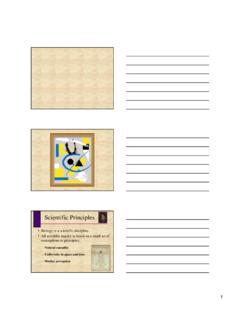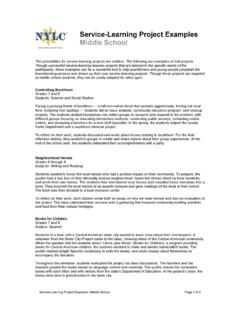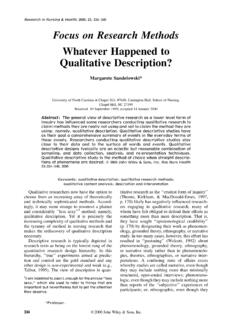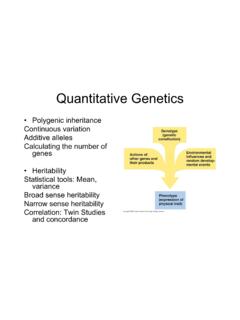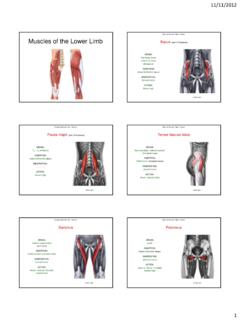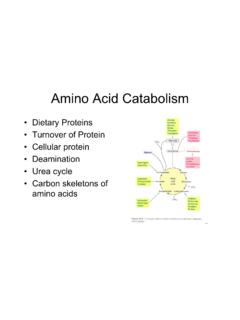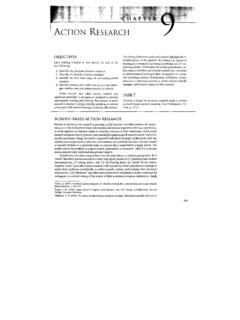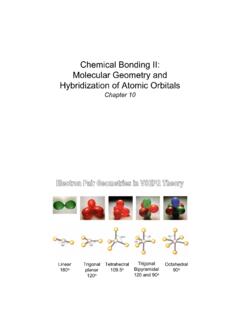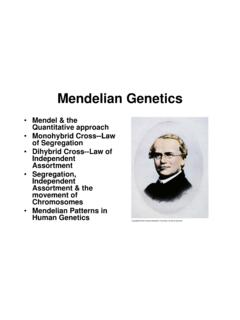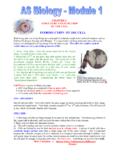Transcription of Chapter 5: Cell Structure and Function - WOU …
1 Chapter 5:Cell Structure and FunctionChapter 5: Cell Structure and FunctionThe Cell is the Basic Unit of LifeEarly History:Robert Hooke(1660 s): Made first observation of cells (cork) Cell= Tiny rooms occupied by monksAnton van Leeuwenhoek(1670 s): Early observations of protistsTheodor Schwann(1830 s): Early observations of animal cells Lack of cell wall delayed discovery (made observation difficult)1) Every living organism is made up of 1 or more cells Smallest organisms = Single cells cells are functional units of multi-cellular organisms2) All cells arise from pre-existing cells Rudolf Virchow(1850 s): Principles of Modern Cell TheoryChapter 5: Cell Structure and Function (Figure )Past / present discoveriesof cell nature enabled viamicroscopy:1) Light Microscopes2) Electron MicroscopesChapter 5: Cell Structure and FunctionBasic Features of All cells :1) Plasma membranesenclose cells and regulate cell / cell and cell / environment interactions2) Genetic Information = DNA Eukaryotic cells (plants/animals): DNA contained in membrane-bound nucleus( True Nucleus ) Prokaryotic cells (bacteria): DNA located to nucleoidregion(not membrane-bound)( Before Nucleus )3) Cytoplasm present Aqueous environment inside plasma membrane Location of cell metabolic activity ( synthesis) Contain ribosomes (protein factories) Chapter 5: Cell Structure and FunctionWhat are the Basic Features of All cells ?
2 4) Energy / Nutrients Obtained from Environment5) Cell Function Limits Cell Size Diffusion too slow in large cells Surface area to volume ratio too low to receive adequate nutrientsChapter 5: Cell Structure and FunctionSurface Area to Volume Ratio: Internal features: Plasma membrane Cytoplasm (w/ ribosomes); Food granules Nucleoid: Central region of coiled DNAC hapter 5: Cell Structure and Function External features: Cell walls Flagellum (movement) Pili(attachment / genetic exchange) Capsule / Slime Layer (host attachment)Features of Prokaryotic cells : Small ( bacteria) Simple in Structure (Figure ) Chapter 5: Cell Structure and FunctionFeatures of Eukaryotic cells : Large and complex in Structure ( our cells ) Internal Features: Plasma membrane Cytoplasm (w/ ribosomes) Membrane-bound organelles/ cytoskeleton(Table )(Figure / ) Chapter 5: Cell Structure and FunctionThe Cell as A City.
3 CityHall(Nucleus)City Workers(Ribosomes)Road System(Endoplasmic reticulum)PostOffice(GolgiComplex)Recycl ingService(Lysosomes)StorageUnits(Vacuol es)PowerPlants(Mitochondria)FoodProducti on(Chloroplasts)CityInfrastructure(Cytos keleton)Plasma MembraneCity WallChapter 5: Cell Structure and FunctionNucleus: Large organelle housing genetic informationParts:1) Nuclear Envelope: Double membrane containing pores2) Chromatin( colored substance ): DNA and associated proteins (chromosomes)3) Nucleolus: Site of ribosome synthesis(Figure ) Chapter 5: Cell Structure and FunctionMembrane System of Eukaryotic cells :1) Plasma Membrane2) Endoplasmic Reticulum(ER) Interconnected tubes and channels Continuous with nuclear membraneA) Rough ER: Major site of protein synthesis (contain ribosomes)B) Smooth ER: Major site of lipid synthesis ( cholesterol)(Figure ) Chapter 5: Cell Structure and Function3)GolgiComplex: Series of flattened, stacked membranes functions :a) Sorts proteins & lipids received from ERMembrane System of Eukaryotic cells :b) Modifies proteins ( sugar units) c) Packages material into vesicles for transport(Figure ) Chapter 5: Cell Structure and FunctionMembrane System of Eukaryotic cells :4) Lysosomes: Vesicles filled with digestive enzymes thatfunction to break down food / cellular debris(Figure )Membrane Systemin Action: Chapter 5: Cell Structure and FunctionVacuoles: Fluid-filled sacs surrounded by single membraneFunctions:1) Water Regulation (ContractileVacuoles).
4 Store and excrete water Freshwater microorganisms ( paramecium)(Figure )Vacuoles: Fluid-filled sacs surrounded by single membraneFunctions: Chapter 5: Cell Structure and Function2) Structural Support and Storage (Central Vacuoles -Plants): Maintains water balance (turgorpressure) Dump site for waste Storage of sugars and amino acids(Figure ) Chapter 5: Cell Structure and FunctionMitochondria: Tubular sacs composed of a membrane pairFunction: Converts food products into energy (ATP) Rely on oxygen (aerobic respiration) Abundant in cells requiring high levels of energy ( muscle) Structure :Cristae: Deep folds in theinner membraneMatrix: Space within theinner membraneIntermembraneCompartment: Space between membranes(Figure )Chloroplasts: Spherical sacs composed of a membrane pairFunction: Convert energy (sun)into food products (sugars) Chapter 5: Cell Structure and Function Specialized plastids (Plastid= storage organelles) Structure :Stroma: Fluid in innermembraneThylakoids: Hollow sacs thatcontain chlorophyllGranum: Stacks of thylakoids(Figure ) Chapter 5: Cell Structure and FunctionCytoskeleton: Internal framework of cell Allow for cell movement Allow for organelle movement Allow for cell divisionTypes of Protein Fibers:1) Intermediate Filaments:8 proteins woven together3) Microtubules: Spiraled double-strands of protein2) Microfilaments: Twisted double-strands of protein Join together to form shape of cellChapter 5: Cell Structure and FunctionCilia ( eyelash)/Flagella ( whip ).
5 Slender extensions of plasmamembrane ( Function = movement) Composed of microtubulesarranged in ring Structure [mitochondria] at base Chapter 5: Cell Structure and FunctionEukaryotic Cell Structure :Membrane Systemin Action:1) Nucleus2) Membrane system Plasma membrane Endoplasmic reticulum Golgicomplex Lysosomes(Figure )Exam on Wednesday:Will Cover: Chapter 1: An Introduction to Life on EarthChapter 2: Atoms, Molecules & LifeChapter 3: Biological MoleculesChapter 4: Cell Membrane Structure and FunctionChapter 5: Cell Structure and FunctionWill Consist of:1) Multiple Choice3) Matching2) True/False4) Fill-in-blank5) Short Answer (Terms/Questions)Example Questions:Multiple Choice:The net movement of molecules from a high concentration toa low concentration is called:A) osmosisB) exocytosisC) active transportD) pinocytosisE) diffusionTrue / False:Compared to eukaryotic cells , prokaryotic cells are small and simple in :Match the following biomoleculetype with the appropriatecharacteristic ( primarily hydrophobic = lipids)Example Questions:Fill-in-Blank:Isotopes refer to atoms of the same element that have differentnumbers of _____ in the :Covalent Bond:Receptor Proteins:Short Answer:List five characteristics of living things.
